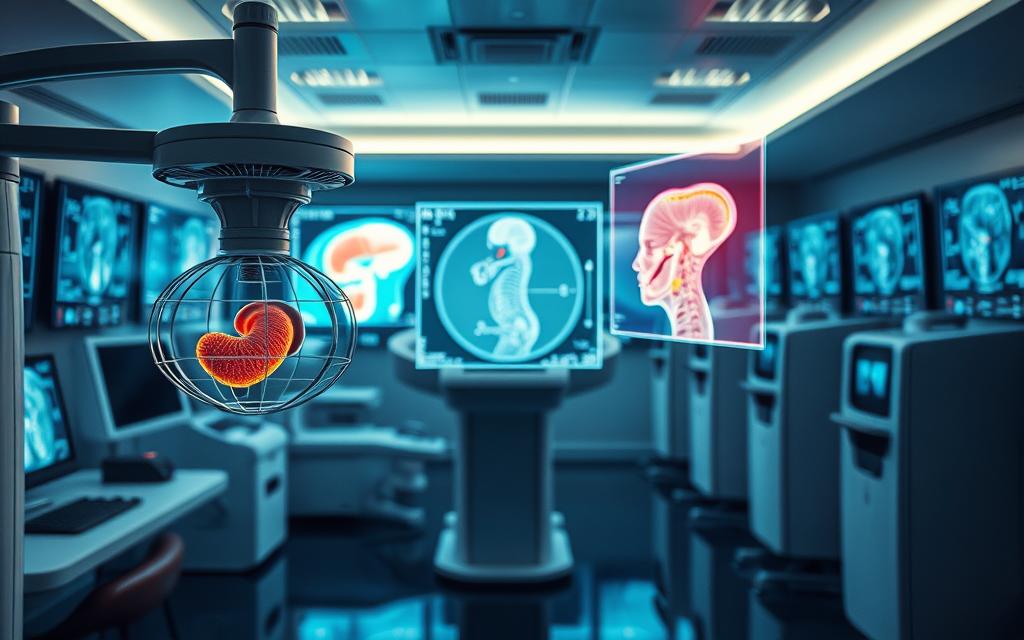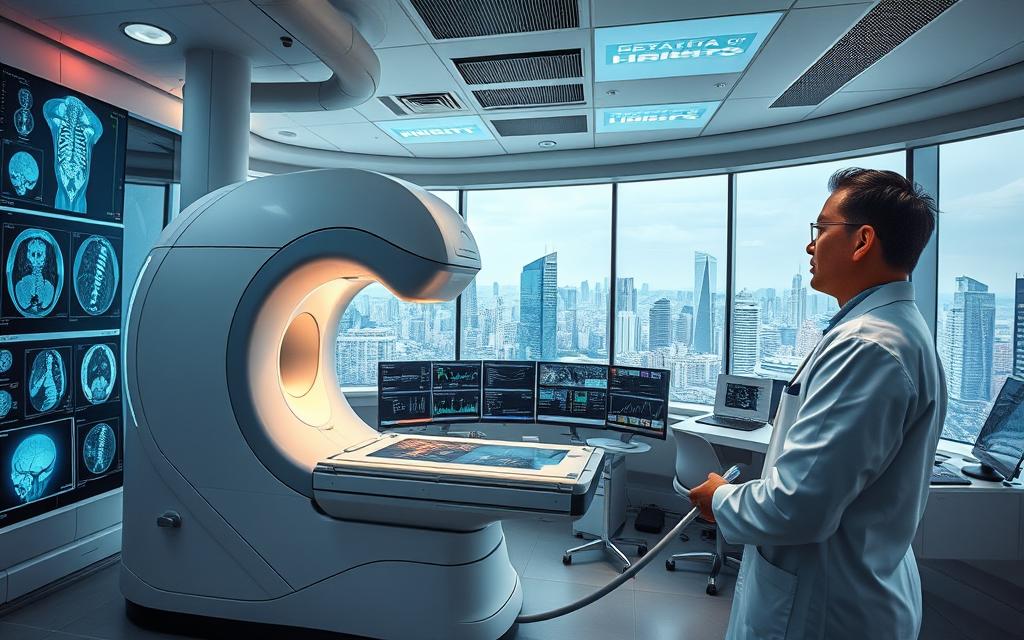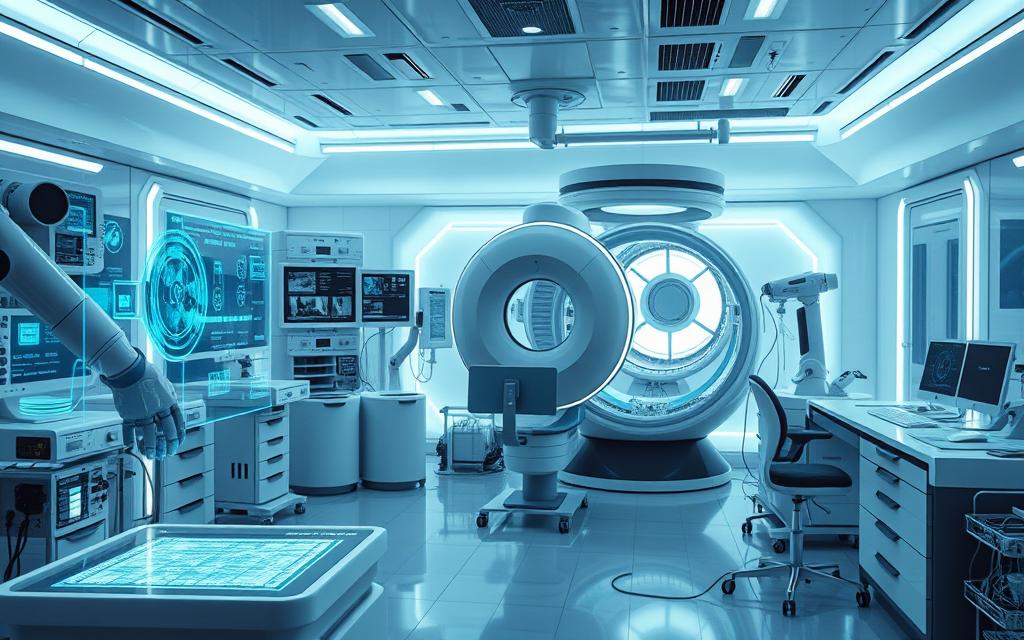The world of medicine has changed a lot, thanks to medical technology advancement. Old healthcare ways, which were slow and focused on one place, are now fast and tailored to each person.
This change in healthcare technology evolution uses new things like Artificial Intelligence and the Internet of Things. These help find problems early and treat them better with digital diagnostics.
This change is not just about new tools. It’s a big change in how we care for patients. Now, we use things like predictive analytics and data to help doctors make better choices.
This article will look at how these new ways are changing innovative treatment methods. We’ll see how they’re making a difference in real life.
The Digital Transformation of Healthcare Practices
The medical world has changed a lot, moving from old ways to new tech-based methods. This big change in healthcare is one of the biggest in history. It has changed how we get and give care.
From Traditional to Technological Approaches
For years, doctors relied on experience and paper notes. But now, digital systems are taking over. Electronic Health Records (EHRs) have made it easier to keep patient records up to date.
Telemedicine lets people talk to doctors from anywhere. It’s a big change. New medical tools like automated pumps make treatments safer and more precise.
Key Drivers Behind Medical Technology Adoption
Many things have pushed technology into healthcare fast. Knowing why this happened helps us see how fast it happened.
Patient Demand for Better Outcomes
Today, people know more about health and want better care. They look online for health info. This makes them want to work with doctors more.
They want quick diagnoses and less invasive treatments. Technology can help meet these needs.
Healthcare System Efficiency Pressures
Healthcare faces big challenges to be more cost-effective. With more older people and higher costs, it needs to work better. Technology helps by making things more efficient.
Systems like EHRs cut down on paperwork. Machines do routine tasks, freeing up staff. Studies show this makes care better and cheaper.
| Traditional Approach | Technological Approach | Impact on Healthcare |
|---|---|---|
| Paper-based records | Electronic Health Records | Improved data accessibility and accuracy |
| In-person consultations only | Telemedicine options | Increased access to care |
| Manual medication administration | Automated infusion systems | Enhanced precision and safety |
| Experience-based decisions | Data-driven decisions | More consistent outcomes |
Patient needs and system needs are driving tech in healthcare. This mix of needs keeps pushing for better tech in care.
How Has Technology Advanced the Medical Field in Diagnostic Capabilities
Modern medicine has seen huge changes thanks to new technology. These changes have changed how doctors find, track, and understand health issues.

Imaging Technology Revolution
Medical imaging has grown a lot. Now, doctors can see inside the body in ways they couldn’t before. This is thanks to better technology.
MRI and CT Scanning Advancements
MRI and CT scans have gotten much better. Modern MRI machines can scan faster and show more detail. CT scanners can now take very clear pictures with less radiation.
These new imaging tools help doctors find problems early. They also help plan treatments better. Artificial intelligence has made analyzing these images even better.
Ultrasound Technology Improvements
Ultrasound has moved beyond just seeing inside the body. Now, it can show movement and tissue stiffness. Portable ultrasound devices make it easy to use in different places.
“The fusion of imaging technologies with computational analysis represents one of the most significant diagnostic breakthroughs in modern medicine.”
Laboratory Diagnostics Enhancement
Laboratory medicine has changed a lot. New technology has made tests faster and more accurate. This is thanks to lab diagnostics technology.
Automated Analysers and Rapid Testing
Today’s labs use machines that can test many samples at once. These machines do lots of tests from one sample. This means doctors can get answers quickly.
Quick tests have changed how doctors work. Tests that used to take days now give answers in minutes. This helps doctors make decisions right away.
Genetic Sequencing Technologies
Genetic testing has changed a lot with new technology. Now, doctors can look at a person’s whole genome quickly and cheaply. This is thanks to next-generation sequencing.
The table below shows how lab diagnostics have improved:
| Technology Type | Traditional Method | Modern Advancement | Impact on Diagnostics |
|---|---|---|---|
| Blood Analysis | Manual cell counting | Automated hematology analysers | Results in minutes vs hours |
| Genetic Testing | Sanger sequencing | Next-generation sequencing | Whole genome in days vs months |
| Infectious Disease | Culture-based methods | Molecular PCR testing | Detection in hours vs days |
| Biochemical Analysis | Manual spectrophotometry | Automated chemistry analysers | Multiple tests from single sample |
Point-of-Care Diagnostic Devices
New portable devices have changed healthcare. They make point-of-care testing easier and more efficient. This is a big change.
Portable Monitoring Equipment
Now, doctors can monitor patients outside hospitals. Devices like portable ECG machines and pulse oximeters give important data. This is a big step forward.
These devices can send data to doctors in real time. This helps doctors keep an eye on patients and act fast if needed.
Home Testing Kits and Wearables
Home health technology has grown a lot. Wearable health monitors track things like heart rate and blood sugar. This is all the time.
Home testing kits can now do complex tests. They are as good as lab tests. This helps people manage their health better.
These tools let people take charge of their health. They also give doctors valuable data for better care.
Using IoT helps gather and use data from many sources. This makes healthcare more personal and proactive.
Treatment Modalities Transformed by Technological Innovation
Breakthroughs in technology have changed how we treat illnesses. They’ve moved beyond just diagnosing to changing how we treat patients. Now, treatments are more precise, less invasive, and tailored to each person, leading to better results.
Minimally Invasive Surgical Techniques
One big leap in medicine is the move to less invasive surgeries. These methods cause less harm, reduce recovery times, and lower risks compared to old-school surgeries.
Robotic-Assisted Surgery Systems
Robotic surgery systems have brought new precision and control to complex surgeries. They turn a surgeon’s hand movements into tiny, precise actions inside the body.
The da Vinci Surgical System is a top example. It offers clear 3D vision and instruments that move in ways humans can’t.
These systems let surgeons do detailed operations through small cuts. They also reduce shaking during surgery, making it more accurate.
Laparoscopic and Endoscopic Advances
Laparoscopic techniques have improved a lot. Better imaging and special tools now allow for more precise surgeries.
Endoscopic tools are also getting better. They’re thin, flexible, and can see inside the body without needing big cuts.
Targeted Therapies and Personalised Medicine
We’re moving away from one-size-fits-all treatments to personalised medicine. This new approach uses genetic info and advanced tests to create treatments just for you.
Genomic-Based Treatment Approaches
Genomic medicine uses your genes to decide on treatments, mainly for cancer and rare diseases. It helps find the right treatments for your body’s unique needs.
Pharmacogenomics helps figure out how your body reacts to medicines. It helps avoid bad reactions and makes treatments work better.
Precision Drug Delivery Systems
Advanced precision drug delivery systems make sure medicines get to the right place. Nanoparticles and smart pills help target treatments, reducing side effects.
Implantable devices slowly release medicines over time. Smart pills track how well you’re taking your medicine and how your body reacts, helping improve treatment.
A study in the National Library of Medicine shows these systems greatly improve treatment results in many areas.
Rehabilitation and Recovery Technologies
Rehabilitation has also seen big changes, making recovery better and longer-lasting for patients.
Advanced Prosthetics and Orthotics
Modern advanced medical rehabilitation includes bionic limbs that respond to muscle signals. They move like real limbs, unlike old prosthetics.
Smart orthotics adjust to your movements and surroundings. They offer support and stability, improving your mobility and comfort.
Tele-rehabilitation Platforms
Tele-rehabilitation lets care go beyond clinics. It uses video, sensors, and wearables for exercises at home.
Virtual reality makes therapy more fun and measurable. It lets therapists see how you’re doing and adjust your plan, keeping care on track.
Data Integration and Artificial Intelligence in Modern Medicine
The healthcare world is changing fast, thanks to data networks and AI. These tools make medical care smarter and more patient-friendly.

Electronic Health Records Systems
Electronic Health Records have grown from simple digital notes to full patient info centers. They are key to managing medical data today.
Interoperability and Data Sharing
EHR interoperability lets different healthcare teams share patient info easily. This means patient data can move with the patient, no matter where they go.
Standard formats and protocols help this sharing. So, doctors in emergency rooms, specialists, and primary care can all see the latest patient info.
Privacy and Security Considerations
Keeping health info safe is a top priority in digital health systems. Strong encryption and access controls protect patient data from hackers.
Healthcare groups must find a balance between keeping data safe and making it accessible. They use many layers of protection to meet rules and keep systems working well.
AI and Machine Learning Applications
AI brings new ways to analyze health data. It looks at huge amounts of info to find patterns that humans might miss.
Diagnostic Pattern Recognition
AI in healthcare diagnostics is great at spotting patterns in medical images and tests. It can find early signs of diseases like cancer or brain disorders.
AI learns from lots of past cases. It gets better at spotting patterns as it sees more data and results.
Treatment Outcome Prediction
Predictive analytics help doctors guess how patients will do with different treatments. AI looks at past data to suggest the best treatments for each patient.
This helps doctors create treatment plans that fit each patient’s needs. It takes into account things like genetic info and past treatments.
Remote Monitoring and Telemedicine
Digital tech lets healthcare reach beyond clinics. Telemedicine services let patients talk to doctors from anywhere.
Chronic Disease Management
Chronic disease remote monitoring keeps an eye on conditions like diabetes and heart disease all the time. Wearable devices send data to doctors in real-time.
This way, doctors can catch problems early. It helps avoid emergencies and hospital stays by managing health proactively.
Rural Healthcare Access Improvement
Remote healthcare helps rural areas get the care they need. Patients can see specialists without leaving home, thanks to telemedicine.
Telemedicine offers many services, like:
- Virtual consultations with specialists
- Remote diagnostic assessments
- Follow-up care and medication management
- Health education and prevention programmes
These advances show how data systems and AI are changing healthcare. They are at the forefront of making care more responsive and accessible.
Conclusion
Technology has changed healthcare a lot, making it more precise and effective. It has brought in new tools like advanced imaging and AI. These tools help doctors give care that fits each patient better.
But, there are challenges ahead. Mixing new tech with old systems is hard. Keeping patient data safe and getting doctors to use new tech is also a big task. The tech world moves fast, and we sometimes struggle to keep up.
The future of healthcare looks bright with more personal care and AI. Companies like Philips, Siemens, and GE Healthcare are leading the way. They are making big steps in medical imaging and monitoring. This shows how tech will keep changing healthcare for the better, worldwide.







